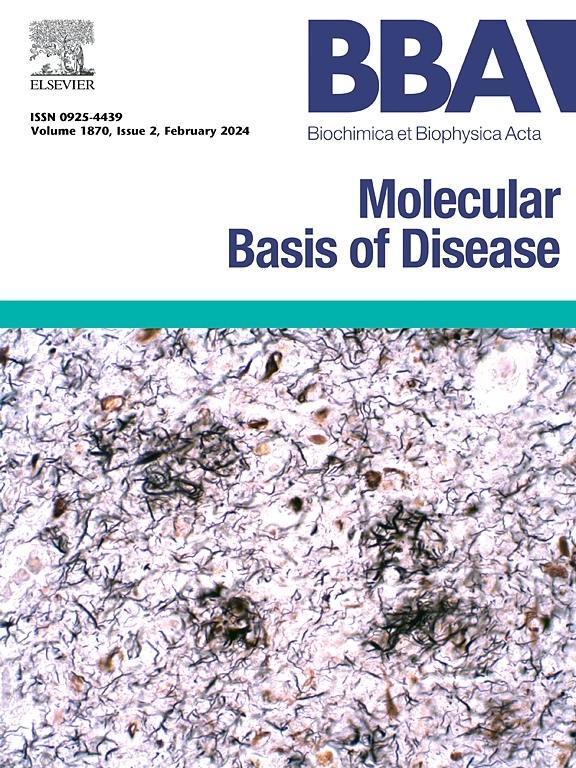Nuclear receptor coactivator 4 linked to follicular dysplasia in polycystic ovary syndrome: A key regulator that aggravates ovarian granulosa cells ferritinophagy and ferroptosis
IF 4.2
2区 生物学
Q2 BIOCHEMISTRY & MOLECULAR BIOLOGY
Biochimica et biophysica acta. Molecular basis of disease
Pub Date : 2025-06-17
DOI:10.1016/j.bbadis.2025.167955
引用次数: 0
Abstract
Ferroptosis is a type of cell death caused by iron-dependent lipid peroxidation and excessive production of reactive oxygen species (ROS). Hyperandrogen exposure can induce ovarian ferroptosis in polycystic ovary syndrome (PCOS). However, there is not enough direct evidence regarding ovarian ferroptosis in PCOS to prove the role of ferroptosis in PCOS and the underlying mechanism. Nuclear receptor coactivator 4 (NCOA4) expression in ovarian granulosa cells and its mechanism of mediating ferroptosis have not been studied. In this study, we aimed to investigate how iron overload in ovarian granulosa cells and hyperandrogen exposure-induced ferroptosis affect ovarian development in a PCOS model. Increased ferroptosis was observed in hyperandrogenic mice with PCOS and in 5α-dihydrotestosterone (DHT)-induced primary granulosa cells. Iron deposition increased significantly, followed by increased cellular Fe2+ concentration, whereas ROS accumulation, malondialdehyde (MDA), glutathione (GSH), and the glutathione/oxidized glutathione (GSH/GSSG) ratio decreased. NCOA4 and transferrin receptor expression increased; however, ferritin heavy chain 1 expression decreased in ovarian tissues. Androgen receptor and NCOA4 showed increased colocalization in the ovarian granulosa cell layer. Notably, DHT induced ferroptosis by activating NOCA4-dependent ferritin autophagy. However, deferoxamine mesylate inhibited ferroptosis in the ovarian granulosa mice cells, ameliorating the PCOS phenotype. Steroid hormone biosynthesis, arachidonic acid metabolism, and unsaturated fatty acid pathways were most significantly affected, providing a reference for PCOS diagnosis and treatment and corresponding drug development.

核受体共激活因子4与多囊卵巢综合征卵泡发育不良相关:一个加重卵巢颗粒细胞铁蛋白吞噬和铁凋亡的关键调节因子
铁下垂是一种由铁依赖性脂质过氧化和活性氧(ROS)过量产生引起的细胞死亡。高雄激素暴露可诱导多囊卵巢综合征(PCOS)患者卵巢铁下垂。然而,卵巢铁下垂在PCOS中的直接证据尚不足以证明铁下垂在PCOS中的作用及其机制。核受体共激活因子4 (NCOA4)在卵巢颗粒细胞中的表达及其介导铁下垂的机制尚未研究。在这项研究中,我们旨在研究卵巢颗粒细胞铁超载和高雄激素暴露诱导的铁下垂如何影响PCOS模型的卵巢发育。在PCOS高雄激素小鼠和5α-二氢睾酮(DHT)诱导的原代颗粒细胞中观察到铁下垂增加。铁沉积显著增加,细胞Fe2+浓度升高,ROS积累、丙二醛(MDA)、谷胱甘肽(GSH)和谷胱甘肽/氧化谷胱甘肽(GSH/GSSG)比值降低。NCOA4、转铁蛋白受体表达增加;铁蛋白重链1在卵巢组织中的表达降低。雄激素受体和NCOA4在卵巢颗粒细胞层的共定位增加。值得注意的是,DHT通过激活noca4依赖性铁蛋白自噬诱导铁凋亡。然而甲磺酸去铁胺抑制卵巢颗粒小鼠细胞的铁下垂,改善PCOS表型。类固醇激素的生物合成、花生四烯酸代谢和不饱和脂肪酸途径受到的影响最为显著,为PCOS的诊断和治疗以及相应的药物开发提供参考。
本文章由计算机程序翻译,如有差异,请以英文原文为准。
求助全文
约1分钟内获得全文
求助全文
来源期刊
CiteScore
12.30
自引率
0.00%
发文量
218
审稿时长
32 days
期刊介绍:
BBA Molecular Basis of Disease addresses the biochemistry and molecular genetics of disease processes and models of human disease. This journal covers aspects of aging, cancer, metabolic-, neurological-, and immunological-based disease. Manuscripts focused on using animal models to elucidate biochemical and mechanistic insight in each of these conditions, are particularly encouraged. Manuscripts should emphasize the underlying mechanisms of disease pathways and provide novel contributions to the understanding and/or treatment of these disorders. Highly descriptive and method development submissions may be declined without full review. The submission of uninvited reviews to BBA - Molecular Basis of Disease is strongly discouraged, and any such uninvited review should be accompanied by a coverletter outlining the compelling reasons why the review should be considered.

 求助内容:
求助内容: 应助结果提醒方式:
应助结果提醒方式:


